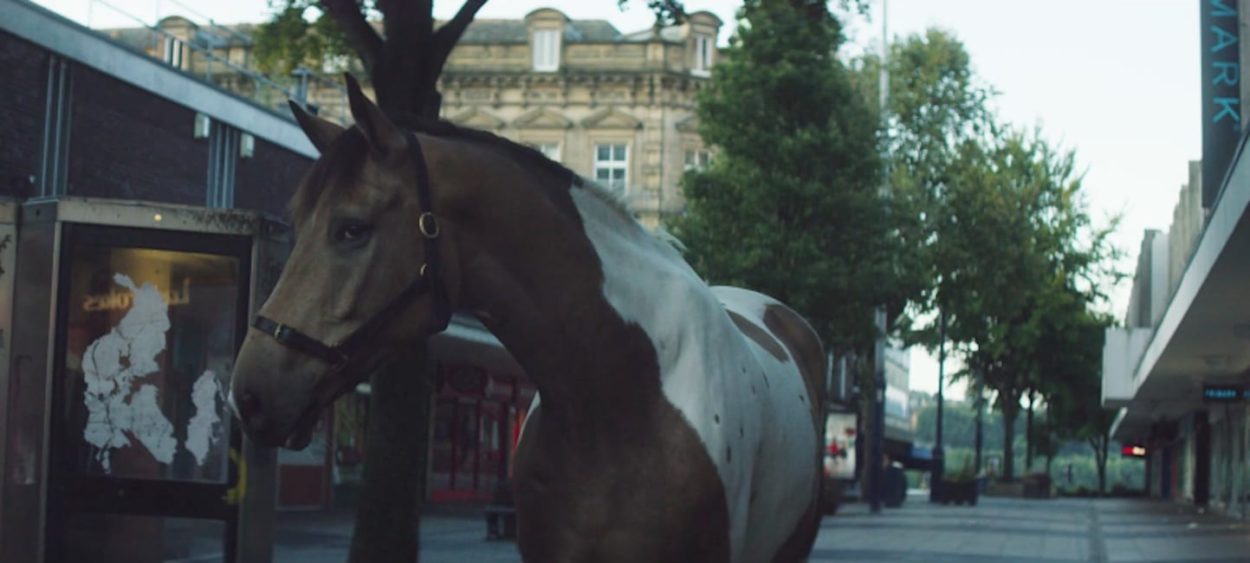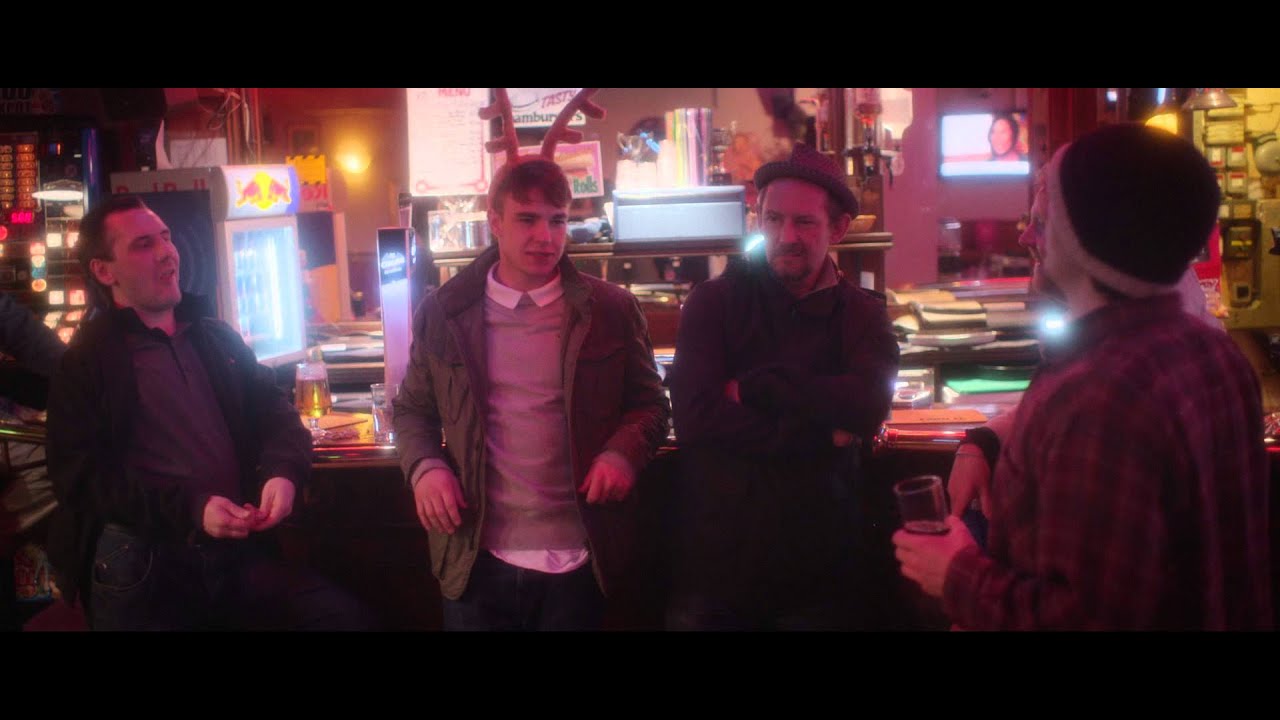Why did you choose Huddersfield as a location and what were your original intentions for the film?
I’m friends with James and Aiden (of Darkstar) having collaborated together on their last album. We were discussing the concept of this album (Foam Island) for about two years, and have similar concerns both artistically and politically.
The album was inspired by Huddersfield, and we knew we wanted to explore the difficulties communities outside of London are facing in an era of never-ending cuts. Huddersfield has a fascinating industrial heritage. And, like many Northern towns, industrial decline hasn’t been compensated for with any kind of infrastructure for the next generation.
During the research process I found it quite poignant that these kids were hanging out in abandoned mills, which 50 years ago they might have worked in.
Please tell us about your production process for creating The Days Burn Blue…
Did you have the narrative planned out before the shoot or did the pace and tone evolve in the edit?
I think it’s pretty imperative to challenge your perceptions about a place by actually going and spending time there. Equally when you’re on a tight budget, you need to rely on the kindness of strangers to be your cast or to let you shoot a location for free.
So I went up and stayed in this quirky halfway house/hotel for eight days and went around meeting people and talking to them about their lives. I’d feed all sorts of ramblings and misspelt locations back to my great producer Matt (Posner) who somehow managed to confirm everything. Approaches on the street resulted in some great experiences: from ending up on a girls night out with some Glamour models to being invited into people’s homes and meeting their families. I won’t forget that sort of kindness and generosity.
Through all the characters and stories what really struck me was the overall lack of opportunity for young people and their sense of abandonment. Kids who are faced with either the accumulation of massive debt if they can afford university or being paid £3.30 p/h if they can get an apprenticeship; a scheme which seems a little questionable. I walked into a clothes shop and the kid behind the till was on a ‘retail apprenticeship’.
This wonderful guy Adenico, who had just left school, knew that moving to London was an impossibility for him, but equally didn’t know why getting a job meant having to leave where you’re from, why ‘the place’ couldn’t just be Huddersfield. I was reflecting on all these conversations whilst walking around the highstreet peppered with ‘To Let’ signs , so the feeling of abandonment felt all the more visceral.
So I took all of the above back to London and placed it within a coming of age structure, but one that was cyclical to represent emerging generations.
How did you go about finding your cast?
It was important for the band to feature as many contributors on the record as possible. I also hung out at youth centres, wandered into dance schools, street cast and filmed community centres at peak times, gently persuading whoever I found there to be apart of the scene. Getting Richard the horse on a highstreet at 5am was a stroke of wild luck and cold calling after a deal between two farmers fell through.
What’s your process for directing untrained actors?
I use the same techniques with professional actors so I think it’s the approach that’s different.
I start off by just being really personable, acknowledging that it’s going to be weird but fun and we’re in it together. I can read a person pretty quickly and know where they’ll sit within a scene and then it’s about finding creative solutions to get what you need to tell the story. I’m always really clear about what their objectives are, what they want and then it’s about creating things that either enforce or get in the way of that. It’s also important to create an environment where people feel comfortable enough to access the ‘trickier’ parts of themselves, everyone I work with is really respectful of that.
Whether it’s John Grant ambling around Dalston or a stag party in Southend, it feels as if you know the local life well. What informs your close familiarity with the communities you feature in your work?
Environments are pretty key in telling a story so I like to understand them both in terms of location and geographically so I know what kind of shoot I’m dealing with. The familiarity entails a lot of walking and talking, I like to be the person to scout the location because invariably that location has someone really interesting in it that I might want to cast.
Is there a political point of view behind your films?
I’m interested in making films about people and the way they live, and there will al-ways be politics to that.
You manage to capture the nuances and idiosyncrasies of people’s lives in what feels like a spontaneous way – do you shoot hours of footage and get these small but powerful moments by accident or is it by design?
I think in order to get those spontaneous moments you need to over-prepare. I really try to make sure everyone in front of the camera is so immersed in what they’re doing that we bring life to each frame. Then it’s about having a clear visual language with your DP so you’re specific in how you’re capturing the chaos.
I’ve been lucky enough to work with really instinctive DPs, like Benjamin Thomas who shot TDBB – he’s so incredibly intuitive in his responses to cast and performance. Equally Ellie Johnson was so in tune with helping me find those moments in the edit.
Locations play a major role in your films – what crew do you use on a shoot? And is there a particular camera and kit you prefer to work with?
It depends on what I’m shooting, but I find myself increasingly moving back towards more nimble crews. That goes for kit also, I went through a stage of only shooting on The Alexa but I need to run around so I’m opting for lighter cameras like the Amira or Red – Scarlet.
We first came across your work when we stumbled across your video for John Grant’s Greatest Motherfucker, a fabulously warm and poignant portrait. Please tell us about your thinking behind this film and how you went about directing it.
I wanted to capture a person who refused to give in to loneliness and explore how a single middle aged man negotiates his place within society. I’m also fascinated in that tension between someone’s private self and how they project themselves in public. There’s a space between the two, a battleground, I find that place interesting.
John has led an incredible life resulting in him being the most personable guy. Really, the most charming man so that was half the battle, he also totally understood what we were saying with each scene. Every location was planned but live, so I’d ask John to go talk to different characters and he’d engage everyone. My DP on the shoot Chris Clark is fearless with live locations. Whenever we work together we slowly infiltrate and accidentally take over. We always seem to end up in a restaurant on a Saturday night, removing light bulbs and queuing waitresses or asking for a certain type of glance from a fellow diner. I think the whole situation is so odd that people end up bewildered and going along with it but you need a crew who don’t get flustered in those scenarios.
How did you get inside the characters you created for Carriages’ Tiny Ruins? (This video incidentally deserves repeat viewings not only for the brilliant act-ing, the juxtaposition of the story and song, it also takes the viewer repeatedly to the edge of violence but never goes down a clichéd route. As a director you know when to back off).
The dynamic of someone you love moving ahead with their lives, how we express ourselves amidst the celebration of other people’s milestones; that juxtaposition of raucous celebration and personal reflection all lends a beautiful tension. I was really interested in how all this could manifest in a Stag-do when you have one character who’s deeply invested in the night and one who isn’t. Pranks that borderline on violence, violence that borderlines on love, not knowing how you place yourself within change.
Are you self-taught or did you learn filmmaking by working in the industry or going to film school?
It was all unfounded self belief, baptism by fire and watching a lot of films. Buying all the dweeby ‘Directing for Dummies’ type books. Writing scripts, saving up to shoot them, wonderfully supportive bosses who let me swap my restaurant/shop/club door shifts so I could go film.
Going to art school and being really into method acting practitioners like Stellar Addler and Stanislavski resulted in me wanting to tell stories about people’s lives. That and a deep understanding that I was fairly unemployable by conventional standards.
How have budgets – either limited or abundant – shaped your film language?
Luckily I grew up fixated with the Cassavettes type approach to filmmaking so coming up on low budgets only affirmed my interest in working alongside real life because it’s all we could afford. I think shooting on a tight budget also means that you have to really interrogate what ‘cinematic’ means, i.e it’s not just about a crazy lighting set up or the best set of lenses, it’s about making bold creative decisions through your visual language, narrative or character.
Now that you’ve signed to Caviar do you see your style of filming changing?
I think it will evolve faster and in the right direction given how supportive, profes-sional and awesome everyone is but I don’t think it’ll ‘change’. Sorcha and Nicola also understand my process and how I need to be ‘on the ground’ to get the results I want, regardless of budget.
Please tell us five inspirations that have connected with you recently:
London fog
MUH-D / TTY
Tom Wood’s ‘Men and Women’
Ulster Botanical Gardens
The Ford Cortina at the bottom of the pond in Hampstead.













